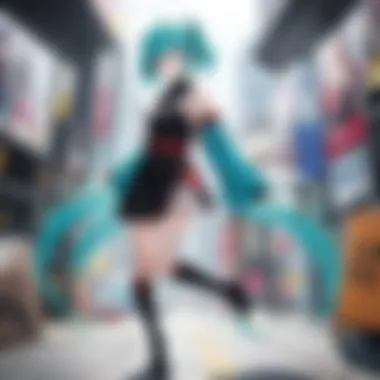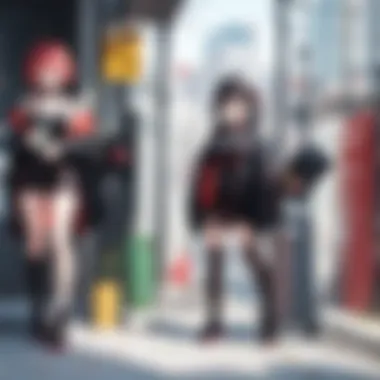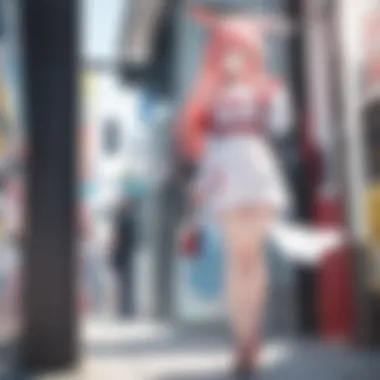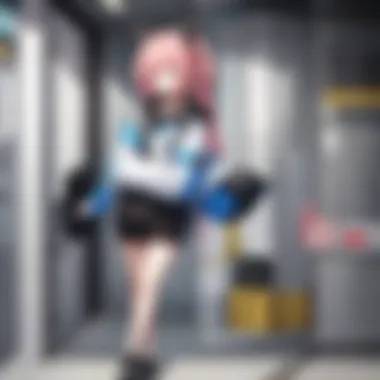Chibi Art Style: A Comprehensive Exploration


Intro
Chibi art style has carved out a unique space in the realms of anime and manga, celebrated for its distinctive aesthetics and character representation. With roots deeply embedded in Japanese culture, chibi serves as a playful and engaging method to depict characters, often accentuating specific traits and emotions. This article aims to dissect the evolution of chibi, its defining characteristics, and the overarching significance it holds within the artistic landscape.
Understanding chibi requires a careful consideration of its origins and how it has transformed over time. The style breaks away from traditional portrayals, opting instead for exaggerated features and simplified forms. This makes chibi art accessible, inviting, and, at times, irresistibly cute. The impacts of this art style ripple through various facets of community interaction and audience engagement, making it not only an artistic choice but also a cultural phenomenon.
As we navigate through the layers of chibi art, we will also uncover how it influences character profiles, thematic elements in narratives, and popular series that define the genre today.
Intro to Chibi Art Style
The chibi art style embodies a distinctive visual language within the realms of anime and manga. This section presents essential insights into why an understanding of this art form is important. Chibi not only serves as a stylistic choice but also a cultural phenomenon that engages a wide audience. It is characterized by exaggerated proportions, often featuring oversized heads and small bodies. These traits evoke a sense of playfulness and innocence, making chibi characters universally appealing.
Exploring chibi art reveals its capacity to convey complex emotions in a simple format. This art form’s simplicity allows for a broad interpretation of characters and their narratives. Through this examination, we recognize how chibi transcends mere aesthetics to shape character dynamics and viewer connection.
In summary, the chibi art style is significant for its unique artistic expressions and its cultural relevance. It invites both viewers and creators to engage in thoughtful exploration of character representation. This foundation prepares readers to appreciate the nuances of chibi and its place within broader artistic movements.
Defining Chibi: A Unique Artistic Expression
Chibi is not just a style; it is a unique artistic expression. It originated in Japan and has roots deeply embedded in manga and anime culture. Artists create chibi characters by manipulating proportionality, concentrating on larger heads relative to their tiny limbs and bodies. This distinct form puts emphasis on cuteness and expressiveness, which appeals greatly to fans.
Chibi often adopts playful and exaggerated facial features. Big eyes express a range of emotions more vividly than traditional proportions might allow. This trait enables creators to depict a character's feelings clearly, fostering a connection with the audience. The charm of chibi lies in its capacity to embody a diverse array of personas while maintaining a consistent, inviting aesthetic.
Cultural Roots and Origin of Chibi
The cultural roots of chibi trace back to the early days of manga, evolving through decades of artistic experimentation. Its origins encompass elements of kawaii culture, which valorizes cuteness and innocence. Starting in the 1980s, chibi began to appear more prominently in comics and animation, particularly through works like "Dragon Ball" and later in various anime genres.
This evolution reflects the shift in societal preferences towards more playful and whimsical representations of characters. As chibi became more widespread, it transcended its original context, spawning a growing global community of artists and fans who embrace the style. The ongoing popularity of chibi today indicates its lasting significance within the dynamics of anime and manga.
Chibi art style symbolizes a rich intersection of cultural values, artistic expression, and community engagement, making it a notable subject of study.
Characteristics of Chibi Art
The chibi art style is a fascinating and specific approach in the realm of anime and manga, capturing attention with its unique attributes. Understanding the characteristics of chibi art is critical for grasping its significance and appeal. These attributes not only define the artistic style but also influence character representation, audience reactions, and cultural outreach.
Proportions and Anatomy in Chibi
In chibi art, proportions diverge significantly from traditional anatomy. Typical chibi characters exhibit a height-to-head ratio of around 1:3, with oversized heads and diminutive bodies. This exaggerated form leads to an illusion of innocence, making the characters appear younger and more endearing. The limbs are usually shortened and simplified, further emphasizing the oversized features. This design choice serves multiple purposes:
- Emotional Connection: The childlike appearance enhances relatability and draws empathy from viewers.
- Visual Clarity: Simplified anatomy allows for quick recognition of character traits and emotions, making it easier for the audience to connect with them.
- Expressive Potential: Oversized heads allow for greater facial expression, contributing to a heightened emotional context within stories.
Overall, the distinct proportions in chibi art create a compelling visual identity that resonates well within stories and media.
Color Palettes and Styles
Color choice plays a pivotal role in defining chibi art. Artists often favor bright, vivid hues that reflect the lively essence of chibi characters. Pastel tones and soft gradients are also common, providing a gentle aesthetic that aligns with the cute and charming nature of chibi designs. These color strategies are significant for several reasons:


- Mood Setting: Bright colors tend to inspire happiness and positivity, which enhances the narrative's emotional core.
- Character Differentiation: Unique color palettes help distinguish characters, contributing to their individuality within a broader setting.
- Kawaii Influence: The choice of colors often ties back to kawaii culture, which emphasizes cuteness and appeals to emotions.
Utilizing diverse color styles, chibi art embarks on a journey exploring characters' personalities and emotional landscapes.
Facial Expressions and Emotions
Facial expressions in chibi art are exaggerated and highly stylized. Artists utilize large, expressive eyes and exaggerated mouth shapes to convey a wide range of emotions. This exaggeration goes beyond mere representation; it communicates personality and emotion instantly. Important aspects of facial expressions include:
- Eye Design: Large, sparkling eyes create a window to the character’s feelings. They reflect joy, sorrow, and every emotion in between.
- Simplified Features: The reduction of complexity in facial features allows for immediate understanding without additional visual clutter.
- Character Depth: Emotive expressions help breathe life into characters, making them feel more real and relatable to the audience.
Overall, the orchestration of facial expressions in chibi art is integral to its charm and effectiveness, allowing characters to resonate deeply with viewers.
Historical Evolution of Chibi Art
Understanding the historical evolution of chibi art is crucial in comprehending its significance in the broader landscape of anime and manga culture. This exploration reveals not only the transformation of artistic styles but also how cultural and social factors have influenced the depiction of characters in a way that resonates with audiences. Chibi art is more than just an aesthetic; it serves as a lens through which we can view changes in artistic expression, consumer behavior, and community engagement over time.
Chibi in Early Manga and Anime
The roots of chibi art can be traced back to early manga, where artists developed distinct stylistic choices to portray characters in a more exaggerated and simplified form. In the 1970s and 1980s, this approach began to emerge as a way to evoke cuteness and appeal to younger audiences. Notable series like Sailor Moon utilized chibi representations to emphasize character emotions and facilitate comedic relief.
At that time, characters would frequently transition into chibi forms during light-hearted moments, showcasing their innocence and humorous traits. This shift was significant for the genre, as it helped establish a unique visual vocabulary that conveyed emotional states swiftly and effectively.
Some key characteristics of early chibi art included:
- Exaggerated proportions: Heads were larger in comparison to bodies, contributing to the characters' adorability.
- Simplistic outlines: Less detailed features made characters instantly recognizable.
- Expressive faces: Wide eyes and exaggerated expressions communicated feelings clearly, enhancing audience connection.
This early usage laid the foundation for chibi's more widespread acceptance within the anime and manga establishments. As a result, a new paradigm was born, allowing chibi art to flourish within various narratives.
Modern Adaptations of Chibi
In contemporary society, the applications of chibi art have expanded remarkably due to technological advancements and globalization. The rise of digital platforms has encouraged artists to explore and experiment with chibi styles, resulting in an even more diverse array of expressions and interpretations.
Today, chibi art is not merely confined to manga and anime. It has transcended into various forms of media, influencing video games, webcomics, and merchandising. Platforms like Etsy and Redbubble feature countless artists selling chibi-themed prints, stickers, and collectibles, highlighting the growing market for these charming characters.
Some notable trends in modern adaptations include:
- Cross-media representation: Chibi characters can now be found in different genres and formats, expanding their reach beyond traditional anime fans.
- Community involvement: Online communities, such as those on Reddit and DeviantArt, allow artists to share and critique chibi works, creating an environment of encouragement and growth.
- Use in digital storytelling: Many creators incorporate chibi art into webtoons and light novels, changing the dynamics of narrative interaction.
Analyzing these adaptations reveals how chibi art continues to play a vital role in contemporary creative expressions, demonstrating its enduring appeal across generations.
Chibi in Popular Media
The chibi art style extends beyond its unique visual appeal, embedding itself into the fabric of popular media. This topic plays a vital role in understanding the reach and influence of chibi aesthetics within both anime and manga cultures. By examining how chibi characters and merchandise are integrated into these mediums, one can appreciate the broader cultural impacts they create.
Chibi Characters in Anime Series


Chibi characters are prominent in many anime series, often used as a tool to convey humor, endearment, or emotional depth. These characters usually exhibit exaggerated proportions, with large heads and small bodies, making them visually distinct. In shows like "Naruto" and "My Hero Academia," chibi representations are frequently employed in comedic scenes or fillers to provide a lighter mood.
Chibi characters can also act as a gateway for audiences to connect emotionally with the main narratives, offering levity amid tension. For instance, the use of chibi representations in emotional moments makes it easier for viewers to engage with the characters' feelings, further intertwining the chibi style with character development.
Another noteworthy aspect is the relatability of chibi characters. Their simplicity and exaggerated features often resonate with viewers, making them more approachable. As a result, these characters foster a sense of affinity, encouraging audience investment in the story. In many ways, chibi can transform how characters are perceived, potentially reshaping audience perspectives regarding the main plot.
Chibi Merchandise and Its Market
The market for chibi merchandise reflects the style's popularity and cultural significance. Products such as figures, plushies, and stickers featuring chibi designs have surged in demand. This growth is attributed to their charm and appeal to a wide audience, particularly among younger fans and collectors. Popular examples include figures from the "Love Live!" series or plush toys from "Pokémon."
The role of online retail platforms cannot be overstated in the expansion of chibi merchandise availability. Websites like Etsy and Amazon host an array of chibi-themed items from independent creators, enriching the consumer experience. Moreover, limited edition releases often create a sense of urgency and exclusivity, which can drive sales and stimulate community conversations.
In summary, the intersection of chibi with popular media, especially within anime and its ancillary products, highlights its significance. This not only shapes perception among fans but also adds another layer to the ongoing dialogue about artistic expression in contemporary culture.
Cultural Significance of Chibi
Chibi art serves as more than just a stylistic choice in the realms of anime and manga. Its cultural significance is profound, capturing the essence of certain societal values, especially in Japan. This section explores how chibi art embodies the principles of Kawaii culture, reflecting a unique aesthetic that has proliferated globally and emphasizes simplicity, cuteness, and emotional connectivity.
Chibi as a Reflection of Kawaii Culture
The term "kawaii" translates to "cute" in English and encompasses an entire culture surrounding the adoration of all things adorable. Chibi characters, with their exaggerated features and child-like proportions, fit perfectly within this framework. By exaggerating the cuteness of characters, artists successfully evoke a sense of affection and familiarity from their audience. This connection is not solely aesthetic; it often speaks to deeper sentiments of innocence and nostalgia, which resonate with audiences across different ages.
Chibi art acts as a tool for accessibility, allowing characters to be approachable. For example, Sailor Moon’s transformation into a chibi character allows viewers to connect with her experiences in a more relaxed manner. Furthermore, this representation often plays into comedic elements within narratives, making it a pivotal part of storytelling in manga and anime forms.
"Chibi art simplifies complex emotions into visual forms that everyone can appreciate."
Community Engagement through Chibi
Chibi art does not just exist as a style; it fosters a rich sense of community. Fans often create art to share their love for specific series or characters. This communal expression strengthens ties within the fandom. Artists showcase their chibi interpretations on platforms like Reddit and Facebook, serving as conversation starters. This engagement is essential for the growth of subcultures within the broader anime and manga communities.
Moreover, events such as conventions often feature chibi art in merchandise and presentations. Artists and fans alike join together to celebrate this style, sharing techniques and experiences related to their creations. Chibi characters often appear in fan art, which is shared widely. Every post of these artworks contributes to a growing repository of fan culture that supports and inspires new generations of artists.
In this way, chibi art becomes a bridge, connecting enthusiasts through shared interests, nostalgic feelings, and a mutual appreciation for cuteness. Its cultural significance cannot be overstated, as it continues to shape the identities of people within the anime and manga landscapes.
Creating Chibi Art
Creating chibi art is central to understanding the style's unique charm and appeal. This section discusses its significance and the methods used to bring chibi characters to life. As a distinct form of representation, chibi art captures emotions and gives personality, drawing audiences into its world. The importance of creating chibi art lies in its accessibility for both artists and enthusiasts alike. Aimed at anime and manga fans, as well as aspiring artists, this section provides insight into the essential techniques and tools needed to excel in this style.
Techniques and Tools for Chibi Drawing
When it comes to drawing chibi characters, several techniques can enhance the creative process. These include both foundational and more advanced methods. Here are some key techniques:
- Sketching Basics: Start with simple shapes to lay out the character's body. Circles and ovals can help define the head and limbs before adding details.
- Proportional Guidelines: Utilize the established proportions typical of chibi, which often involve a larger head relative to the body. This approach emphasizes the cute factor.
- Line Art: Once the sketch is in place, refining it with clean and smooth lines is essential. Many digital artists use software like Adobe Photoshop or Clip Studio Paint for this purpose.
- Coloring: Applying colors can bring a chibi character to life. It’s important to choose a vibrant palette to align with the fun spirit of chibi art.
- Shading and Highlights: Adding depth through shading is often important. Consider using a lighter and darker shade of the base color to create highlights and shadows effectively.
Tools vary based on the medium chosen. Traditional tools include pencils, markers, and watercolors. In digital art, tablets and styluses are essential for precision. Many artists rely on specific software to create polished digital chibi art. The techniques artists employ reflect their personal style and the message they want to convey.
Digital vs. Traditional Methods


The choice between digital and traditional methods is a crucial one that affects the process and end result of chibi art. Both methods offer unique benefits and considerations.
Digital Methods:
- Flexibility: Digital art allows for easy alteration without the need to start over, making it forgiving for mistakes.
- Variety of Tools: Various software programs offer unique brushes, textures, and effects that can enhance chibi art.
- Layers: The use of layers enables the artists to separate elements, smoothing the workflow, especially for detailing.
Traditional Methods:
- Tactile Experience: Many artists prefer the feel of paper and traditional materials like pens and paint. This can enhance creativity and satisfaction.
- Immediate Process: Creating physical art provides instant gratification, as you can see and touch the final piece immediately.
- Limitations: Once a mark is made, it cannot be easily undone, which forces more caution at the start of the drawing process.
Ultimately, both digital and traditional methods lend themselves well to chibi art, and the decision often depends on personal preference and desired outcomes. Some artists may choose to blend both techniques to harness the strengths of each.
The choice of medium in chibi art says as much about the artist as the art itself, revealing individual strategies and preferences.
Analyzing the Appeal of Chibi Art Style
Chibi art style holds a unique place in the hearts of anime and manga enthusiasts. Understanding its appeal is crucial to realizing how it influences various aspects of fan culture. Chibi carries elements that deeply resonate not just visually, but also emotionally. Its exaggerated proportions and cute designs make it easy to connect with characters. This connection fosters a sense of belonging within the communities that appreciate this art form.
Psychological Aspects of Chibi Aesthetics
The psychological impact of chibi aesthetics is multifaceted. One significant factor is how the style enhances emotional responses. Chibi characters often display large eyes and small bodies, creating a subtle suggestion of innocence and vulnerability. This representation may evoke protective instincts in viewers, drawing them closer to the characters.
Research suggests that cute stimuli can activate the brain's reward center. Thus, chibi characters generate positive feelings and can reduce stress. Furthermore, these characters often embody exaggerated expressions. Their wide smiles or tearful eyes amplify emotional states, allowing for immediate viewer engagement. This connection can lead to both empathy and admiration.
Chibi art doesn’t just entertain; it also offers a safe space for emotional expression. Fans often project their feelings onto these characters, using them as avatars in their personal narratives. This allows for exploration of emotions in an uncomplicated manner, making chibi a tool for self-reflection.
Audience Reception and Critique
Chibi art occupies a dual role within the broader discourse of anime and manga fandom. While many enthusiasts celebrate its charm and accessibility, there are critiques worth noting. The appeal of chibi can also lead to questions about authenticity in character design. Some traditionalists argue that chibi reduces the complexity of characters, limiting narrative depth.
Despite criticism, the audience reception tends to outweigh negative perspectives. Many fans appreciate how chibi art can transform well-known characters into something playful and lovable. Chibi often finds its place in merchandise, illustrations, and social media, amplifying its visibility and engagement.
Moreover, the rise of platforms like Reddit and Facebook has allowed discussions about chibi to flourish. Users frequently share their chibi art creations and engage in constructive critiques. This interaction styles fosters community, where differing opinions and styles can coexist. This vibrant exchange serves to enrich the overall appreciation of the chibi art form.
"Chibi art not only adds variety to character representation but also brings communities together through shared appreciation of creativity."
Epilogue: The Future of Chibi Art
As we look onward into the world of chibi art, it becomes clear that this distinct style is not merely a passing phase in the anime and manga landscape. Instead, it stands as a testament to the evolving nature of artistic expression, continuously adapting to the tastes and preferences of audiences both young and old. The chibi aesthetic captures the essence of characters in a way that emphasizes their emotions and playfulness, engaging viewers in a manner that few other styles can.
Trends and Predictions
Looking towards the future, several trends emerge within the chibi art community. One significant trend is the crossover between chibi art and digital platforms. As social media continues to influence art distribution, artists increasingly utilize platforms like Instagram and TikTok to showcase their chibi creations. This has opened new avenues for artistry, enabling artists to reach wider audiences and engage with fans directly.
Additionally, there is a growing emphasis on inclusivity and diversity within chibi art. Artists are exploring various cultural influences and styles, leading to a richer, more varied representation of characters in chibi form. This trend not only reflects the changing demographics of anime fans but also allows for broader engagement with global cultures. Merchandise featuring diverse chibi characters is also on the rise, indicating that consumers are responding positively to these shifts.
In terms of style evolution, we can expect to see more experimentation with hybrid forms. This includes incorporating elements from different genres or merging traditional and digital methods. New tools and software are continually being developed, making it easier for artists to blend various techniques.
Chibi's Influence on New Generations of Artists
Chibi art serves as an accessible entry point for aspiring artists. Many young creators are drawn to the simplicity of the chibi form, which allows them to develop their skills without overwhelming detail. This has resulted in a new generation that is not only skilled in chibi drawing but also embraces its cultural roots and meanings.
Moreover, the sense of community within the chibi art sphere fosters learning and collaboration. Online forums, such as those found on Reddit and Facebook, allow artists to share tips, receive feedback, and showcase their work. This collaborative spirit encourages innovation, pushing artists to explore new themes and ideas through the lens of chibi.







